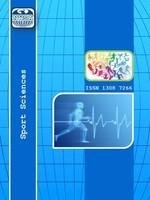OLİMPİYATLAR İÇİN SPORDA YETENEK SEÇİMİ VE SPORA YÖNLENDİRME PROJESİ II. AŞAMA SONUÇLARININ İNCELENMESİ (BURSA ÖRNEĞİ)
Bu araştırmanın amacı Bursa ilindeki Olimpiyatlar için Sporda Yetenek Seçimi ve Spora Yönlendirme Projesi II. Aşama sonuçlarının incelenmesidir. Bu çalışma 7-12 yaş grubundan 210 öğrenciyi kapsamaktadır. Pençe kuvveti, 20 sn mekik, 30m. (20+10 m) sürat koşusu, otur&eriş, sekiz koşusu, durarak uzun atlama, sağlık topu fırlatma, mekik koşusu (sadece 11-12 yaş grubu) testleri uygulanmıştır. İstatistiksel değerlendirilmeler S.P.S.S. programında yapılmıştır. İki grup arasındaki faklılıkları incelemek amacıyla Independent T testi, ikiden fazla grup arasındaki faklılıkları incelemek amacıyla One Way Anova ve Bonferroni testleri kullanılmıştır. Sonuç olarak, 7-12 çocukluk döneminde hız, koordinasyon, beceri ve kuvvet yaşa ve cinsiyete göre farklılık göstermektedir. Bu farklılık yaşla birlikte doğru orantılıdır ve cinsiyete göre karşılaştırma yapıldığında erkekler lehine bulunmuştur. Elde edilen sonucun bu alandaki mevcut literatüre uygun olduğu görülmektedir.
Anahtar Kelimeler:
Yetenek Seçimi , Sprint, Kuvvet, Dayanıklılık, , , , ,
EXAMINING THE II. LEVEL RESULTS OF THE TALENT SELECTION IN SPORTS AND DIRECTING TO SPORTS PROJECT FOR THE OLYMPIC GAMES (BURSA SAMPLE)
The aim of this research is examining the II. level results of the talent selection in sports and directing to sports project for the Olympic games in Bursa. This study which includes 210 students between the ages 7 and 12. In the field test sections; hand grip strength, 20 sec sit up, 30 m speed (20 + 10 m), sit and reach, eight figured agility test, standing jump, medicine ball throw, 20 m shuttle running (only 11-12 age) were tests performed. These statistical evaluations were done in SPSS programme. To find the difference between two groups Independent T test, to find the difference between more than two groups One Way Anova and Bonferroni tests were applied. As a result, speed, coordination, skill and strength show differences in the childhood period between the ages of 7 and 12. This difference is well-proportional with the age and when it is compared with the gender the results were found in favour of boys. It can be seen that the findings are appropriate to the present literature.
Keywords:
Talent Selection , Sprint, Power , Endurance, , , , , ,
- Başlangıç: 2009
- Yayıncı: E-Journal of New World Sciences Academy
